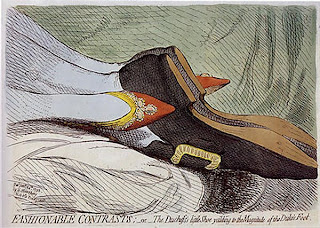Put a lock on your computer and turn off your wi-fi! The
internet is awash with porn and we are all doomed.
Heard any number of variations on this theme? Of course you
have. Previously innocent men and women will turn into slavering monsters
because they have been exposed to sexual imagery, although what is or is not offensive is open to debate. No one has managed to come up
with a definitive classification system for pornography as opposed to
eroticism. What is pornographic seems to be very much in the eye of the
beholder. One thing most critics seem to agree on is that the spread of porn is
due to the internet and it is the plague of the twenty first century!
 That’s wrong, of course.
Sexually explicit material, aimed at titillation and excitement has been
around since...well as long as people have. Some cultures, like the Romans,
made a virtue of their erotic art, using it to decorate the walls of their
houses. In India you will see erotic carvings on temple walls. It wasn’t
something to be hidden away or ashamed of. It was there, where men, women and
children saw it, and still see it, every day. I haven't heard many people in the West at least protesting about that. Maybe because it is old enough to be excused as culture or history.
That’s wrong, of course.
Sexually explicit material, aimed at titillation and excitement has been
around since...well as long as people have. Some cultures, like the Romans,
made a virtue of their erotic art, using it to decorate the walls of their
houses. In India you will see erotic carvings on temple walls. It wasn’t
something to be hidden away or ashamed of. It was there, where men, women and
children saw it, and still see it, every day. I haven't heard many people in the West at least protesting about that. Maybe because it is old enough to be excused as culture or history.
The past is more complex and more surprising than you might
be aware. Most of us only come into
contact with History at school. By necessity a lot of the more controversial
material has been white-washed and only acceptable information is passed on. As
a result we tend to think of the people of this time as bastions of morality
and mannered behaviour, whose passions were restricted to war and occasionally
trade.
That isn't strictly accurate. Let me give you an example. When I was at school I learned
about Samuel Pepys. He was an observant and witty commentator on life in
seventeenth century British society. I was never told that he devoted sections
of his famous diary to the subject of his sexual activities, including random sexual
encounters with wives of acquaintances and chance met women. He wonders whether
it is right to continue his habit of masturbating in church if the daily sermon
is not interesting. That’s right. Samuel Pepys whacked off IN CHURCH!
One of the things that got Samuel’s motor going was erotic
literature...seventeenth century porn. The novel may eventually have become
respectable, but the earliest and most popular forms were erotic novels—with
illustrations. No wonder the clergy and
members of the establishment despised the novel, and continued to do so long
after it had become a respectable and popular medium.
Pepys himself apparently had a particular fondness for one of the
first erotic novels, L’Ecole des Filles.
Twentieth century works like The Story of O are part of a long
tradition starting with books like L’Ecole des Filles translated into English as School for Venus. It is “an illustrated sexual dialogue between two
women.” Yes folks, even in the seventeenth century, guys liked girl on girl
action. Pepys kept the book for a while for inspiration, then burnt it before
his wife found it. And he recorded the whole thing in his diary, including the number of times he masturbated while reading it—wisely making
the entries in a unique code made up of a combination of Italian and French and
symbols he devised himself. He records his interest in enacting some of
the scenes if he could find another woman to participate.
 Another French erotic novel available in England was Thérèse Philosophe, a massive best
seller, not only in France but elsewhere including Britain, where pornographic works
were the most popular publications of the time. Besides fairly graphic
depictions of sex between Thérèse and a priest (There’s a long literary history
of that --Heloise and Abelard for one and Chaucer mentions it) there
is a chapter where Thérèse’s new protector places her in a room with a
collection of erotic books, statues and paintings and bets her she cannot go
two weeks without masturbating. She loses, of course and the description of her
self-pleasuring while her soon to be lover watches is astonishingly hot: so
much so that I used the incident for inspiration for a small scene in my story,
a Boudoir for Three .
Another French erotic novel available in England was Thérèse Philosophe, a massive best
seller, not only in France but elsewhere including Britain, where pornographic works
were the most popular publications of the time. Besides fairly graphic
depictions of sex between Thérèse and a priest (There’s a long literary history
of that --Heloise and Abelard for one and Chaucer mentions it) there
is a chapter where Thérèse’s new protector places her in a room with a
collection of erotic books, statues and paintings and bets her she cannot go
two weeks without masturbating. She loses, of course and the description of her
self-pleasuring while her soon to be lover watches is astonishingly hot: so
much so that I used the incident for inspiration for a small scene in my story,
a Boudoir for Three .
Historical novelists have long hinted at arcane societies
that existed to indulge in sexual excesses. These groups certainly existed at
this time. Most of the novels I have read cast members of these groups as the
villains, in many cases, rightly so. The
class system meant that members of the upper classes, the aristocracy
in particular, didn’t bother with the inconvenient issue of consent, especially
if their chosen victim was of a substantially lower class. The Marquis de Sade, who gave his name to
sadism, took this to the extreme. His book, 120
Days of Sodom, has scenes of extreme cruelty and de Sade’s pleasure depends
very much on the victims being unwilling. De Sade was jailed for his writings,
even though there is some suggestion most of the scenes he claims to have
participated in were imaginary. I find them so distasteful I cannot read more
than the introduction of the work.
I don’t in any way defend any act that does not involve
consenting adults, but there were other places where indulgence was entirely of
a consenting nature. Many society marriages were based on economic and social
considerations, there was a generally held belief that morality was a
middle-class concept, and while young, unmarried girls were guarded closely to
protect their reputations, once a married woman had provided her husband with
an heir and a spare, provided she did it discreetly, she was free to indulge in
whatever sexual dalliances she chose.
 Boredom and privilege left these people
searching for anything to entertain them and sexual exploration offered a brief
respite from ennui. Private balls were held where rooms were provided for quick
sex. Masks provided the discretion required. Gatherings happened in private
homes and occasionally in places dedicated to what we could only call sex clubs
in rooms decorated with erotic paintings and statuary and furnished with
couches where patrons could indulge in multiple partners, group sex, oral sex,
voyeurism and more. Select members of the upper crust attended. Often the host
also provided willing females (and occasionally young men) from lower orders.
At these parties attractive young women who lived outside of society hoped to
find a protector to make her his mistress. Paris was a popular location for
these clubs. Georgette Heyer hints at it in her novel These Old Shades, where his Grace of Avon sends his page Leon away
from one such gathering so that he might not be corrupted
Boredom and privilege left these people
searching for anything to entertain them and sexual exploration offered a brief
respite from ennui. Private balls were held where rooms were provided for quick
sex. Masks provided the discretion required. Gatherings happened in private
homes and occasionally in places dedicated to what we could only call sex clubs
in rooms decorated with erotic paintings and statuary and furnished with
couches where patrons could indulge in multiple partners, group sex, oral sex,
voyeurism and more. Select members of the upper crust attended. Often the host
also provided willing females (and occasionally young men) from lower orders.
At these parties attractive young women who lived outside of society hoped to
find a protector to make her his mistress. Paris was a popular location for
these clubs. Georgette Heyer hints at it in her novel These Old Shades, where his Grace of Avon sends his page Leon away
from one such gathering so that he might not be corrupted
Some of the more risqué adventures rumoured to have taken place,
sometimes involving well known historical figures would shock anyone, even
today. The Russian Empress, Catherine the Great, taking the idea of hung like a stallion way too literally,
was reported to have rigged a lifting harness so she could have intercourse
with a horse. Some accounts even said she died of a rupture caused by this.
Happily, it wasn’t true. She did have a great sexual
appetite and had a string of lovers, but the horse rumour was put about by her
enemies. I imagine this comes as a source of relief not only to Catherine’s
descendents but also to the horse.
The erotic has been with us since humans first began to
represent ideas in art and language. As with all human endeavour, some of it is
good, some is poor and some pushes the boundaries of what we can tolerate.
Tastes change, ideas change, but interest in sex is hard wired into us. Alongside
humanity’s continued interest in the sexual, there has always been someone
trying to tell us it is wrong. So far, they have failed dismally to convince
us. And long may they continue to fail. Consensual sex is good, dirty fun and
doesn’t hurt society at all...and we have history to back us up.







No comments:
Post a Comment